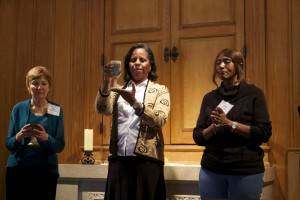From Access to Equity:
Women’s Pathways into the Church
“Wherever two or three women gather together . . . the men get nervous.”
Judging by the laughter in the room, Molly Marshall’s sound bite of wisdom hit the mark. Marshall, a long-time advocate for women in ministry and president of Central Baptist Theological Seminary (Shawnee, Kansas), delivered her message by video to the “Access and Equity for Women in the Church Conference” October 25-26.
The strategy conference was sponsored by the Equity for Women in the Church Community of the Alliance of Baptists and hosted by Wake Forest University School of Divinity (WFDiv). Two years in the planning, the meeting brought together participants from the Alliance, the Evangelical Lutheran Church of America (ELCA), Church of Christ, Presbyterian Church USA (PCUSA), The Episcopal Church, United Church of Christ, United Methodist Church, American Baptist Churches USA, National Baptist Convention USA, and the Cooperative Baptist Fellowship.

The question of what makes people nervous about women’s leadership has many answers. However, anxiety was not the main focus of the historic gathering. Rather, what can and should be said, done, and supported to expand women’s pastoral leadership was the center-point of the two-day conversation.
A “Double Stained Glass Ceiling”
The conference met one of its top goals by bringing together a diverse group of women and men from various racial-ethnic and denominational groups to speak forthrightly about challenges facing women called to ministry. In some denominations, the largest barriers remain at the point of “access,” where women fill less than one percent of the pastorates. For example, ordained minister and professor at Wake Forest, Veronice Miles is the only woman her home church, an African-American Baptist congregation, has ever ordained.
For other groups, women’s access remains a narrow path. The percentage of women pastoring in Alliance and mainline congregations ranges between 22 and 31 percent. Many women, like Alliance board member and Conference Co-chair, Sheila Sholes-Ross, travel a long winding road to church leadership. Sholes-Ross has been a candidate 31 times in pastoral searches over the past five years.
Even in churches that call women, concerns remain for “equity” on issues like pay and benefits, moving into a second pastoral call, and coping with systemic sexism and racism that lives in the social structures and relational networks of churches. Like women in business and academia, far too many women remain underpaid and underemployed, and often they drop out of their professions in frustration.
Another top concern of the conference was captured in Steve Sprinkle’s report from his small group breakout session. The professor at Brite Divinity School, and former Alliance board member, said: “The challenge for women finding pastorates, is impacted by gender and race. We are cognizant of the double challenge that exists for women, a double stained glass ceiling.” The group began sharing stories with each other that showed the impact of gender and race, and effectively, “made these stories real.” Sprinkle says, “It’s one thing to talk about these issues in the abstract, but it’s another thing entirely to give them a human face.”
Circling Around
Conference facilitator Cheryl Dudley invited the group to gather in two very different circles near the beginning and end of the conference. In the first circle 10 people locked arms and held the circle tight, facing inward while others were asked to “find a way in.” Episcopal priest, Virginia Marie Rincon, got into the circle by “going in underneath,” reflecting the covert path and subversive power struggles often required for women in pastoral ministry.
The next day Dudley, Global Religions Director for the Arcus Foundation, invited participants into a different configuration. Facing one another in two concentric circles, this time each group locked arms and began moving slowly in opposite directions, singing “Blest Be the Tie That Binds.” Each person looked into the eyes of others, and feelings of belonging and support filled the circle, expressing themselves in voices, tears and smiles.
The largest portion of the meeting was spent in small circles of conversation naming the issues of access and equity faced by women in the church, considering the double stained glass ceiling shaped by gender and race, and imagining ways to move beyond these and other barriers to a new day for the church. Conference co-chair Jann Aldredge-Clanton said, “The gathering was inspiring beyond my highest expectations! The participants not only brought amazing gifts and experience, but also deep passion and commitment for the work. We left with renewed energy for making reality the big vision of equal representation of clergywomen in multicultural churches in order to transform church and society.”
The women (and men) have gathered. If you don’t like change . . . . Well, you might be feeling nervous about now.





The conversations have only begun!
Just heard Mollie Marshall’s words and wish I could have attended this meeting. My heart beats with all of you who were there.
This is a GREAT overview of the conference! Thanks Eileen for also talking about the “2nd circle” of affirmation and support! Let’s “keep the fire going” indeed!
Thanks also to Jann Aldredge-Clanton for sharing her insights about this historic gathering at: http://jannaldredgeclanton.com/blog/?p=2351
And many thanks to Christine Smith for her lovely summary of the meeting at her blog:
http://shepastor.blogspot.com/2013/10/shepastor-make-vision-plain-equity-and.html
Eileen
Thank you, Eileen, for writing your insights about this historic strategy meeting! I especially appreciate your comments about the two circles. Also, thank you for your generous contributions to this conference, and for your outstanding scholarship that for many years has advanced the cause of women in ministry. Yes, we are moving forward together to bring change to church and society!